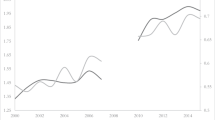Conclusion
As a result of credit supply imperfections and inelastic demand, creditworthy consumers may not fully benefit from accurate credit assessments as is implied by the concept of qualified demand. Yet, despite the existence of house rates and prepackaged credit offers, consumers are still able to shop around for the best terms from creditors who are all competing to make profitable credit extensions. If creditors become less accurate in their credit risk assessment due to ECOL, as the cited empirical studies predict, their opportunity to make profitable credit extensions has diminished. In a competitive credit market, credit availability would decline as creditors would be compelled either to raise rates to compensate for greater default losses and other costs associated with less accurate credit evaluation or to cut those costs by applying more stringent credit standards. Otherwise, credit institutions would be unable to earn a return on invested capital sufficient for the risk involved and the supply of consumer credit funds would diminish. With the existing credit market, creditors may not be as compelled by competition to raise house rates (or able, if such rates are at ceiling levels) or raise credit standards, as is implied by a highly competitive market. However, creditors would still have the same economic incentive to repond to increased costs of doing business in ways which would reduce credit availability to qualified demanders. Furthermore, as credit extensions become less profitable, the economic penalty accorded invidious discrimination is diminished and credit grantors, who are so inclined, are more likely to engage in such practices. Alternatively, if legislators focused upon increasing competition in the consumer credit market, increased credit availability would result. And as this would increase the economic penalty for invidious discrimination, such practices would decline.
Similar content being viewed by others
Notes
Gordon Allport,The Nature of Prejudice, (Cambridge, Mass.: Addison Wesley Press, 1955), p. 9.
Gary S. Becker,The Economics of Discrimination, 2nd Ed., (Chicago: The U. of Chicago Press, 1971), pp. 13–16.
Garry Chandler and David C. Ewert, “Discrimination on the Basis of Sex Under the Equal Credit Opportunity Act,” Working Paper No. 8, Credit Research Center, Purdue University.
The National Commission on Consumer Finance,Consumer Credit in The United States, (Washington: D.C.: U.S. Government Printing Office, 1972).
Joan Robinson,The Economics of Imperfect Competition (London: MacMillan, 1936), p. 79.
Douglas F. Greer and Robert F. Shay, “Preliminary Model Specifications for the Personal Loan Market,”The National Commission on Consumer Finance-Technical Studies, Vol. IV (Washington, D.C.: U.S. Government Printing Office), p. 6.
Benjamin M. Friedman, “Credit Rationing: A Review,”Staff Economic Studies (Board of Governors of the Federal Reserve System, 1972); pp. 2-6.
Marshall Freimer and Myron J. Gordon, “Why Bankers Ration Credit,”Quarterly Journal of Economics, 79 (August 1965), pp. 397–398. These authors propose two forms of credit rationing: “A banker who practices ‘weak credit rationing’ will vary the amount he is willing to lend a borrower with the interest rate up to a limit. Only beyond this limit will he refuse to extend credit regardless of the interest rate. A banker who sets an interest rate, lends a borrower whatever he wants up to a predetermined level at this rate, and refuses to lend him more regardless of the rate will be referred to as practicing ‘strict credit rationing.’ ”
Eli Clemens, “Price Discrimination and the Multi-Product Firm”Review of Economic Studies, XIX (1950–51), p. 5.
Douglas F. Greer, “Rate Ceilings, Market Structure, and the Supply of Finance Company Personal Loans,” Journal of Finance, 29 (December 1974).
For a proof, see Dwight M. Jaffee and Franco Modigliani, op. cit.
Empirical evidences confirming this economic analysis in the labor and consumer goods markets is given by Sowell, op. cit.
The National Commission on Consumer Finance—Technical Studies, Volume IV, (Washington, D.C.: U.S. Government Printing Office, 1972).
Dwight M. Jaffee and Franco Modigliani, “A Theory and Test of Credit Rationing, ”American Economic Review, 59 (December 1969), pp. 856–859.
Paul F. Smith, “Pricing Policies on Consumer Loans at Commercial Banks,” Journal of Finance, 25 (May 1970), p. 517.
F. Thomas Juster and Robert F. Shay, Consumer Sensitivity to Finance Rates: An Empirical and Analytical Investigation, Occasional Paper No. 88 (New York: National Bureau of Economic Research, 1964), p. 2.
Thomas A. Durkin, “Consumer Awareness of Credit Terms: Review and Evidence,” Journal of Business, 48, (April 1975), pp. 253–263.
James F. Smith, “The Equal Credit Opportunity Act of 1974: A Cost/Benefit Analysis,” Journal of Finance, 32 (May 1977), p. 620.
William C. Dunkelberg, “A Lower Rate Maximum for Retail Credit: The Impact on Consumers,” The National Commission on Consumer Finance-Technical Studies, op. cit.
Bernard A. Shinkel, “The Effects of Equal Credit Opportunity Legislation in Consumer Finance Lending,” Working Paper, Wayne State University.
About this article
Cite this article
Shinkel, B.A. The economics of discrimination in the granting of credit. Rev Black Polit Econ 9, 416–434 (1979). https://doi.org/10.1007/BF02891731
Issue Date:
DOI: https://doi.org/10.1007/BF02891731




